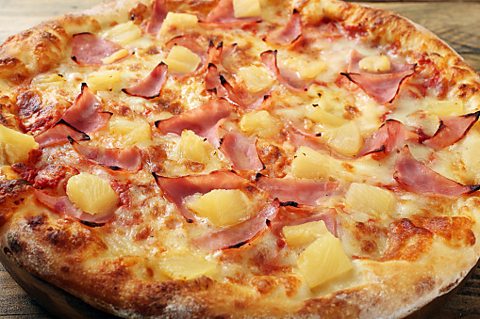ItÔÇÖs the food choice that seems to divide the world.
Is pineapple an acceptable pizza topping?
It frequently causes arguments online with memes for and against pineapple as a topping shared almost every day, and our opinions on potential friends, film stars and sportspeople are regularly formed using the pineapple-on-pizza method.
But why is it so controversial and where did it even come from? ┤¾¤¾┤½├¢ Bitesize grabs a slice of the action.

The origin of the Hawaiian
The modern pizza we know today evolved from dishes created in Naples, Italy in the 18th and 19th Centuries.
Italians take their pizza very seriously, particularly in Naples, where the local pizza received traditional speciality guaranteed status by the EU in 2009, protecting the original pizza base recipe and its production methods against misuse or falsification.
But the Hawaiian pizza, topped with ham and pineapple, was not an Italian invention.
And despite the name, according to a popular story, it might not have come from the US island state of Hawaii either. Early references to pineapple as a pizza topping date back to the mid-1950s, with the term ÔÇÿHawaiianÔÇÖ being used to describe a pizza topped with the fruit and other combinations of ingredients later on in that decade.
But the pizzaÔÇÖs commercial success is often pinpointed as having been sparked in Canada by a Greek immigrant called Sam Panopoulos in 1962.
Panopoulos, along with his brothers, owned a restaurant in the province of Ontario. The food was initially very simple - traditional diner dishes such as pancakes and burgers. Inspired by a recent trip to Naples, Panopoulos decided to introduce pizza to the menu.
It was a relatively new dish in North America and, at the time, with most pizza being served with mushrooms, bacon or pepperoni as toppings. Panopoulos did the same, but as he became more adventurous with other dishes, introducing Americanised versions of Chinese meals such as sweet and sour chicken, which also includes pineapple, he decided to take a risk with his pizzas as well.
The story goes that he added canned pineapple to one pizza, with ham ÔÇô not knowing whether it would be a hit or not, but soon found the combination of sweet and savoury was proving a winner with his customers.
But why? One possible reason is the growing fascination at the time with Tiki culture. Hawaii had officially become an American state in 1959 and people had fallen in love with the island lifestyle. Canned pineapple began to be imported into North America, along with pineapple juice - providing Panopoulos with his crucial ingredient.
As for the name, the brand of tinned pineapple was called Hawaiian, so PanopoulosÔÇÖs invention was named in its honour.
Why do people hate Hawaiian pizza?
From its humble Canadian beginnings, the combination spread across North America, and ultimately the world - but despite its global appeal, pineapple pizza has remained controversial.
A 2017 YouGov poll found that 82% of people surveyed liked pineapple, but only 53% liked the fruit on their pizza. 12% of people said they disliked it on pizza a little bit while 29% said they hated the idea.

One of the main arguments is that pineapple breaks with tradition ÔÇô that fruit, tomato aside, has no place on a pizza.
Gudni Thorlacius Johannesson, president of Iceland, caused a minor international incident when he joked with school pupils that, given the chance, he would ban pineapple on pizza.
It led to Hawaiian pizzas being sent to the Icelandic Embassy in London and Justin Trudeau, prime minister of Canada, passionately defended his countryÔÇÖs culinary contribution in a tweet.
But why?
Master pizzaiolo (pizza chef) Franco Pepe owns a restaurant in Caiazzo, north of Naples. HeÔÇÖs been named the best pizza maker in the world on multiple occasions - but hasn't shied away from using pineapple as a topping, winning an award for his take on the controversial pizza.
Speaking to food website La Cucina Italiana, Pepe said he thought the reason many were against pineapple was because it clashed too much with the base sauce.
ÔÇ£The combinations were probably too risky: the pineapple was combined with tomato!
ÔÇ£Double acidity, which invariably resulted in a weak taste and poor digestibility. In addition, the pineapples were from cans, pre-cooked under syrup with a huge addition of other sugars.ÔÇØ
PepeÔÇÖs critically acclaimed pineapple pizza uses fresh fruit and serves it cold, wrapped in prosciutto ham ÔÇô an approach that he says allows the natural taste of the pineapple to shine through.
But despite his fine dining take on the Hawaiian, the standard tinned fruit option remains incredibly popular.
Hawaiian fans say they like the combination of sweet and savoury flavours ÔÇô a trend that has become fairly common on menus in recent years thanks to things like salted caramel.
And who hasnÔÇÖt been to a childÔÇÖs birthday party where pineapple and cheese chunks on sticks were served?
But in the end, it comes down to personal choice ÔÇô a point referenced by Icelandic President Johannesson, who said: ÔÇ£As much as I do not like pineapple on pizza, the individual freedom of having the topping of your choice overrides that.ÔÇØ
And with Dwayne ÔÇÿThe RockÔÇÖ Johnson openly admitting that pineapple on pizza is his preferred choice, who is to argue? Love it or hate it, Hawaiian pizza is here to stay.
This article was published in October 2020 and last updated in July 2024

What makes a good guitar riff?
Experts share the building blocks behind a memorable musical sequence that stays with you forever

Five well-known animals that went extinct in Britain
Elk, lynx and brown bears all used to roam across Britain.

Seven words that describe that cosy autumnal feeling
From hygge to gezelligheid, the untranslatable words that perfectly sum up that autumn feeling.
